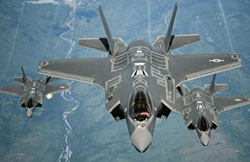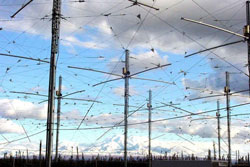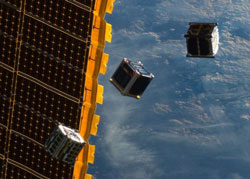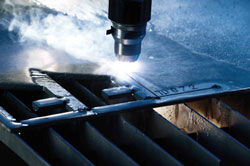US Air Force Plans To Plasma Bomb the Sky for HAARP!
 Radio communication is a weak point for most military operations – it is often not long enough or strong enough to adequately meet soldiers’ needs. The U.S. Air Force’s “go big or go home” solution to improve their long-distance calls? Supercharge the atmosphere by detonating aerial plasma bombs attached to tiny satellites, reports New Scientist.
Radio communication is a weak point for most military operations – it is often not long enough or strong enough to adequately meet soldiers’ needs. The U.S. Air Force’s “go big or go home” solution to improve their long-distance calls? Supercharge the atmosphere by detonating aerial plasma bombs attached to tiny satellites, reports New Scientist.
The Air Force is asking for help in developing plasma bombs, which would be delivered to the atmosphere by tiny cube satellites and then detonated to release ions upon arrival. The Air Force is working with several research teams, each of which is tasked with coming up with their own design for the plasma bombs. The first stage of the project is theoretical, requiring researchers to come up with an atmospheric plasma delivery method. Selected researchers then will be invited to test their proposal in a vacuum chamber simulator and eventually on exploratory flights.
One team, comprised of researchers from Drexel University and General Sciences, is developing a controlled bomb that uses a chemical reaction to heat a piece of metal beyond its boiling point. Once vaporized, the metal will react with atmospheric oxygen to create the ionized plasma. Another proposal under development by researchers from the University of Maryland and Enig Associates also uses vaporized metals to supercharge the atmosphere. This proposal is much more explosive, though, using mini-detonations to heat pieces of metal rapidly, causing them to vaporize. The amount of plasma produced in this latter reaction can be controlled by changing the intensity and form of the explosion.
 Though using plasma bombs may be unconventional and even controversial, the science behind the Air Force’s plan is sound. By releasing plasma bombs into the atmosphere, the Air Force would increase the quantity of ions in the layer of the atmosphere known as the ionosphere, which starts at an altitude of approximately 60 kilometers. Radio waves interact with this layer when they travel, so modifying it can have a significant effect on radio communications.
Though using plasma bombs may be unconventional and even controversial, the science behind the Air Force’s plan is sound. By releasing plasma bombs into the atmosphere, the Air Force would increase the quantity of ions in the layer of the atmosphere known as the ionosphere, which starts at an altitude of approximately 60 kilometers. Radio waves interact with this layer when they travel, so modifying it can have a significant effect on radio communications.
Radio signals released by a ground source travel upward until they hit the ionosphere and bounce back to Earth in a zigzag pattern. Radio waves that bounce between the ionosphere and ground are able to travel longer distances. This bounce-back effect is influenced by the number of ions in the ionosphere. By using plasma bombs to increase the number of charged particles in the atmosphere, the Air Force expects to improve this bounce-back effect and boost communications. As a side effect, the Air Force also notes that this dense ion layer also will neutralize incoming solar storms, protecting sensitive networks such as GPS from disruption.
The idea of artificially ionizing the atmosphere to improve radio communications is nothing new and is already being used in Alaska. The High Frequency Active Auroral Research Program uses ground-based antennas to bombard the ionosphere with radiation. This radiation produces radio-reflecting plasma that, in turn, improves radio communication. The plasma bomb idea builds upon the HAARP program by modifying the ionosphere directly instead of relying on ground-based technology. Despite its promise, though, it is not known whether these plasma bombs will be powerful enough to make any significant changes in atmospheric ionization.
US Air Force wants to plasma bomb the sky using tiny satellites
 Since the early days of radio, we’ve known that reception is sometimes better at night. Radio stations that cannot be picked up by day may be heard clearly at night, transmitting from hundreds of kilometers away.
Since the early days of radio, we’ve known that reception is sometimes better at night. Radio stations that cannot be picked up by day may be heard clearly at night, transmitting from hundreds of kilometers away.
This is down to changes in the ionosphere, a layer of charged particles in the atmosphere that starts around 60 kilometers up. The curvature of Earth stops most ground-based radio signals travelling more than 70 kilometers without a boost. But by bouncing between the ionosphere and the ground they can zigzag for much greater distances. At night the density of the ionosphere’s charged particles is higher, making it more reflective.
This is not the first time we’ve tinkered with the ionosphere to try to improve radio communication and enhance the range of over-the-horizon radar. HAARP, the High Frequency Active Auroral Research Program in Alaska, stimulates the ionosphere with radiation from an array of ground-based antennas to produce radio-reflecting plasma.
Direct delivery
 Now the USAF wants to do this more efficiently, with tiny cubesats (a type of miniaturized satellite for space research that is made up of multiples of 10×10×11.35 cm cubic units), for example, carrying large volumes of ionized gas directly into the ionosphere.
Now the USAF wants to do this more efficiently, with tiny cubesats (a type of miniaturized satellite for space research that is made up of multiples of 10×10×11.35 cm cubic units), for example, carrying large volumes of ionized gas directly into the ionosphere.
As well as increasing the range of radio signals, the USAF says it wants to smooth out the effects of solar winds, which can knock out GPS, and also investigate the possibility of blocking communication from enemy satellites.
There are at least two major challenges. One is building a plasma generator small enough to fit on a cubesat – roughly 10 centimeters cubed. Then there’s the problem of controlling exactly how the plasma will disperse once it is released.
The USAF has awarded three contracts to teams who are sketching out ways to tackle the approach. The best proposal will be selected for a second phase in which plasma generators will be tested in vacuum chambers and exploratory space flights.
Vaporized metal
 General Sciences in Souderton, Pennsylvania, is working with researchers at Drexel University in Philadelphia on a method that involves using a chemical reaction to heat a piece of metal beyond its boiling point. The vaporized metal will react with atmospheric oxygen to produce plasma.
General Sciences in Souderton, Pennsylvania, is working with researchers at Drexel University in Philadelphia on a method that involves using a chemical reaction to heat a piece of metal beyond its boiling point. The vaporized metal will react with atmospheric oxygen to produce plasma.
The other team, Enig Associates of Bethesda, Maryland, and researchers at the University of Maryland, are working on a more explosive solution. Their idea is to rapidly heat a piece of metal by detonating a small bomb and converting energy from the blast into electrical energy. Different shaped plasma clouds can be generated by changing the form of the initial explosion.
However, it’s not clear whether the USAF will succeed. “These are really early-stage projects, representing the boundaries of plasma research into ionosphere modification” says John Kline, who leads the Plasma Engineering group at Research Support Instruments in Hopewell, New Jersey. He thinks one of the biggest stumbling blocks will be packing enough power to generate plasma onto small satellites. “It may be an insurmountable challenge.”
David Last, former president of the UK’s Royal Institute of Navigation, is skeptical about USAF’s ambitions to counteract the effects of solar wind. When solar storms disrupt GPS signals, the entire side of Earth facing the sun is affected, he says. Ironing out those disturbances would require an extremely large and speedy intervention. “You don’t calm a stormy sea by filling in the gaps”, says Last.
yogaesoteric
February 16, 2017
